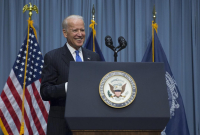Support strong Canadian climate journalism for 2025
The same week one of B.C.’s proposed LNG projects was delayed, Canada’s energy minister mused about the risk of fossil fuel investments as the clean energy transition picks up speed.
The final investment decision for the Cedar LNG project, backed by the Pembina Pipeline Corp. and the Haisla First Nation, will be postponed until mid-2024, it was announced last week.
Ongoing negotiations to secure customer contracts, third-party agreements, project financing and the rising capital costs for the liquified natural gas (LNG) project, originally estimated at US$2.4 billion, were cited as reasons for the delay.
Just days before the delay was announced, Energy and Natural Resources Minister Jonathan Wilkinson suggested LNG projects might be risky investments moving forward, especially in the context of the International Energy Agency forecasting a “gas glut” by 2025. The market for all fossil fuels is expected to peak by the end of the decade.
“The market is increasingly saying the transition is happening and it's probably happening faster than a lot of people think,” Wilkinson said.
Proponents of new LNG facilities have to look at the market and determine whether there will be sufficient demand, he added.
“There's a question around [LNG project] timelines, and certainly concerns about stranded assets,” Wilkinson said.
The minister made the comments while speaking with Canada’s National Observer following his announcement on Feb. 21 that Ottawa has secured the retirement of the remaining offshore oil and gas rights on the West Coast.
Whether it’s offshore oil or the viability of LNG projects, companies will be evaluating if future investments make financial sense with the shift to renewable energy, he said.
Future LNG projects must fit with Canada’s 2030 climate goals — which will include a long-promised plan to cap emissions from oil and gas production and the requirement that the fossil fuel sector cut methane emissions by a minimum of 75 per cent by 2030 from 2012 levels, he added.
Meeting methane reduction targets means LNG production will need to rely on clean electricity, not natural gas, and the eventual phasedown of natural gas power plants to meet the 2050 net-zero emissions target, he said.
A flooded market and climate concerns prompted U.S. President Joe Biden’s recent decision to pause further approvals for LNG export projects, Wilkinson said.
Following the U.S. move, climate groups urged Canada and British Columbia to do the same, but neither the minister nor the province has shown any inclination to follow suit.
Both levels of government have previously championed LNG export schemes, arguing the fossil gas will replace the use of coal, a dirtier fossil fuel, in other countries like Korea and Japan. However, critics argue there's little evidence that this is actually the case.
In addition to LNG Canada and Cedar LNG, five other projects are in various stages of development on the West Coast.
Fugitive emissions from methane, the main component of fossil gas, are the second greatest contributor to spiking global temperatures after carbon dioxide. Methane leaks occur at every step of the LNG life cycle, including fracking, flaring, the liquifying process and shipping to Asia.
B.C. has backed LNG, saying emissions will be addressed by electrification with renewable energy and yet-to-be-realized carbon capture and storage technology in conjunction with future emissions caps.
Critics argue using tax dollars to electrify LNG — prolonging the life of the industry and the burning of fossil fuels responsible for superheating the planet — locks investment in a dying industry and diverts funds and finite electrical resources from climate solutions like renewables, heat pumps and infrastructure to charge zero-emission vehicles.
Recent polling shows public support for LNG projects in B.C. is on a downward slide, with 65 per cent of survey participants believing companies should cover any electrification costs needed to decarbonize.
The federal government subsidized Phase 1 of the LNG Canada project, set to come online in Kitimat by 2025, to the tune of $275 million. And it’s under pressure to offer up more, so Shell and its partners can roll out a Phase 2 expansion, said Sven Biggs, oil and gas program director for Stand.earth.
Outstanding LNG projects in B.C. slated to come online toward the end of the decade won’t be competitive without ongoing government subsidies, Biggs said.
The Cedar LNG announcement can be interpreted as a setback, given the cooling market after a short surge of optimism following the pandemic and nervousness about Russian gas supply when the Ukraine war began, he said.
Pembina reported it was still pursuing negotiations and described the project as “competitive.”
The key regulatory approvals are in place for the floating LNG facility in Kitimat. However, the partners had previously stated the decision would occur in the first quarter of 2024, with construction launching in the middle of the year.
Electrification and developing carbon capture and storage for the oil and gas sector are prohibitively expensive and will only happen if taxpayers fund it, Biggs observed.
Shell has said it won’t make a final investment decision on Phase 2 of the LNG project without government help around electrification or, alternatively, that it will go ahead and power the facility with fossil gas, putting governments’ emissions targets in peril, Biggs added.
“Ultimately, we'd love to see the federal government do more than just talk about the risk of LNG and make it clear that there will be no more subsidies for these kinds of projects,” he said.
“That sends a clear message to investors that there isn't a road forward for most of these LNG projects.”
The federal government’s new speaking points on the financial risks of investing in LNG are welcome but ineffectual, said Marc Lee, senior economist with the Canadian Centre for Policy Alternatives.
“I agree there's a risk of stranded assets for the industry,” Lee said. “Although a lot of that risk is contingent upon the world actually dramatically reducing its consumption of fossil fuels.”
Renewables are increasing exponentially but still only represent a small fraction of what’s needed to displace the planet-warming emissions from burning fossil fuels.
Rapidly phasing out the oil and gas industry is the number 1 measure necessary to meet climate targets at home and abroad, Lee stressed.
Canada is the world’s fourth-largest producer of crude oil and ranks fifth for fossil gas. Fossil fuel production accounted for 28 per cent of Canada's greenhouse gas emissions, according to the latest figures — nearly double the amount the sector emitted in 1990.
“The de facto position being taken by a lot of Canadian politicians is, ‘We'll try to reduce our domestic emissions as much as we can,’” Lee said.
“But on the industrial side, we won't really do anything to constrain production.”
Alberta’s oilsands output continues to rise at record rates, in step with B.C.’s natural gas production.
B.C.’s LNG expansion projects aren’t even online, but fracked gas production in the province reached record levels in 2023 and has doubled since 2010, according to the Canadian Association of Petroleum Producers.
Promised federal and provincial emissions caps, if they don’t offer industry loopholes and prove effective at curbing production, are still years away from being realized, Lee said.
“The only thing that’s going to reduce the size of [Canada’s fossil fuel] industry on the supply side is if other countries stop buying what we’re selling.”
Rochelle Baker / Local Journalism Initiative / Canada’s National Observer
— With files The Canadian Press and John Woodside & Natasha Bulowski / Canada’s National Observer







Comments
The official noise is changing pitch. But the signal has yet to follow. The feds must put our money into renewables, not fossil fuels.